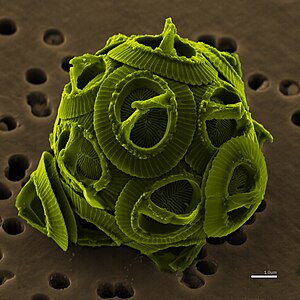Coccolithophorida
| Coccolithophorida | ||||||||||
|---|---|---|---|---|---|---|---|---|---|---|

False color image of Gephyrocapsa oceanica |
||||||||||
| Systematics | ||||||||||
|
||||||||||
| Scientific name | ||||||||||
| Coccolithophorida | ||||||||||
| Lemmermann , 1908 |
The Coccolithophorida (also Coccolithales, Coccolithophorales or Coccolithophyceae, German: Kalkflagellaten ) are a systematic group ( taxon ) of complex unicellular algae from the superordinate group Haptophyta . They are characterized by the fact that the organic cell body is surrounded by a ball of calcium carbonate platelets, the coccosphere . The individual limestone platelets are called coccoliths and always consist of the mineral calcite . With a size of often less than 20 µm, lime flagellates are counted among the calcareous nannoplankton . From some epochs of recent geological history , limestones have been passed down that consist almost exclusively of coccoliths, including the chalk stone after which the Cretaceous period is named.
Etymology and Taxonomic History
The name Coccolithophorida goes back to Coccolithophora Lohmann, a now invalid generic name ( synonym of Coronosphaera ). Since earlier investigators were still unclear whether they should assign the group to the plant kingdom or the animal kingdom (as aberrant " flagellates "), they were described in both groups with different nomenclature rules . Accordingly, the name Coccolithophoridae (a family, using the ICZN for "animals") was first coined , later Coccolithophoraceae using the ICBN . Later, on this basis, an order Coccolithophorales was established, which was later called Coccosphaerales (placed in the class Prymnesiophyceae).
Lime flagellates in geological history
The limestone flagellates occurred in the history of the earth rock-forming. During these times they must have multiplied extremely strongly in the uppermost part of the water column of the shelf seas and have sunk (sedimented) to the sea floor at the end of their life cycle. From the resulting sediment , the so-called coccolith sludge, limestone was subsequently formed by diagenesis . Coccolith form inter alia an essential part of chalk rocks of complaints , Mon and the southern England Kreideküste at Dover . One cubic centimeter of chalk contains around 800 million coccoliths. The first reliable finds of the coccolithophores come from the Triassic . They achieved their greatest distribution and variety of forms in the chalk . The great mass extinction at the end of this age caused a sharp decline in these algae. They reached a new high point of diversity and distribution around 50 million years ago in the Eocene . The recent genus Braarudosphaera can be traced back to the Cretaceous.
They are important for science, because their fossil remains in the sediments allow conclusions to be drawn about the age of these deposits as well as the prevailing environmental conditions.
literature
- Peter Reinhardt: Coccoliths. Limestone plankton for millions of years (= Die Neue Brehm Bücherei . No. 453 ). A. Ziemsen Verlag, Lutherstadt Wittenberg 1972, ISBN 978-3-7403-0214-6 ( online ).
- M. Lluïsa Cros i Miguel: Planktonic Coccolithophores of the NW Mediterranean. Doctoral thesis, Department d'Ecologia, Universitat de Barcelona, 2001 ( online ).
Web links
- Calcareous Nannofossils on MIRACLE (Microfossil Image Recovery And Circulation for Learning and Education), an image database of the Department of Micropalaeontology at University College London (English)
Individual evidence
- ↑ Coccolithophora Lohmann, 1902 at AlgaeBase
- ↑ Amos Winter, William G. Siesser: Coccolithophores. Cambridge University Press, 2006. ISBN 978-0-521-03169-1 .
